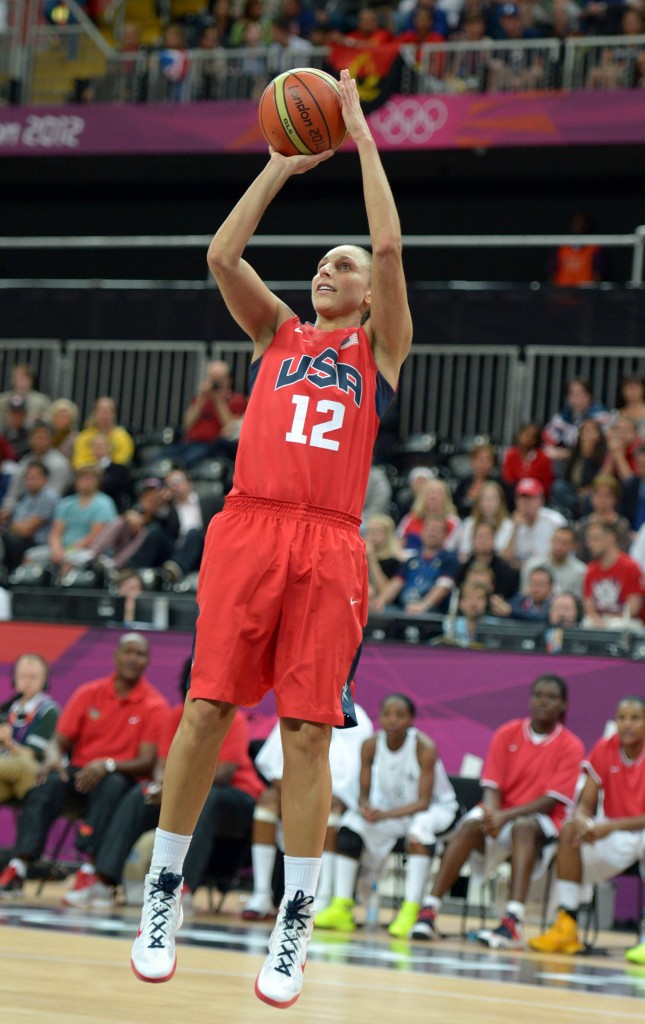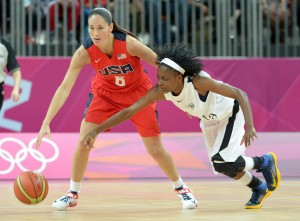
The USA women’s basketball team defeated an undermanned Angola 90-38 in each squad’s second game of the 2012 Olympics. Here are some positives and negatives that come out of the Americans’ dominating performance.
The Positives
USA’s mid-range game wreaks havoc on opposing teams’ defensive game plans.
It was clear that Angola wanted to apply aggressive, physical ball pressure to the American guards. Team USA, for all intensive purposes, tried its best to attack this pressure early in the contest. But in the half court, the pressuring Angolans were effective in steering many USA ball-handlers away from the basket.
No worries, though.
That same aggressive style by Angola only allowed USA to execute its off-the-ball screens and offense. Utilizing mostly pin-downs on the block and lateral screens near the short corner, USA consistently hit their wings coming off screens near the middle of the floor from 15-17 feet.
A multitude of players, including the 6 foot Seimone Augustus, were able to hit mid-range jump shots. In fact, USA totaled 6 made shots from the 15-17 foot range in the second quarter alone, some even coming in transition off ball reversals or cross-court passes. In total, they shot 12-15 from that range.
Collective, deadly daggers.

Although it seemed that Angola had a good plan to accept its size disadvantage and pressure the Americans in the backcourt, it proved fruitless due to USA’s ability to hit from anywhere on the floor (it should be noted that Angola did force 11 turnovers in the first half. USA finished with 14 total).
Their transition game is too organized not to work.
If you’re a basketball fan, this team is fun to watch in the open floor because they run it like a team that’s been playing together for years (Showtime Lakers? Nah – but still fun to watch). It’s longer forwards were constantly running up the middle of the floor and providing easy targets for guards Sue Bird and Lindsay Whalen. Maya Moore became the beneficiary on multiple offensive transitions in this spot. Speaking of Whalen and Bird – they did superb in not forcing the action. While they controlled their speed in the middle of the floor, this allowed the wings to sprint out wide and provide plenty of options.
Candace Parker, mainly playing the center position with Sylvia Fowles on the bench with an injury, served as a dedicated trailer. The secondary option was clearly a ball screen set by Parker. This worked effectively as Parker herself slipped for a couple easy baskets.
Between their transition game and ability to hit anywhere inside of 17 feet, this USA women’s team will serve as near impossible to stop from scoring.
The Negatives
Team USA from three-point range: 2-18 (11%)
Hey – when you win by 52 points there isn’t much to look at negatively. Plus, they still shot 55% as a whole. However, there was one issue that was most apparent in the first half…
USA’s zone defenses are far from impenetrable.
Geno Auriemma came out in the first quarter with an aggressive 2-3 zone in the half court. Angola, despite its lack of height and a reliable post presence, continually found holes with dribble penetration. Angolan guard Sonia Guadalupe seemed most effective in this after hitting an early three-pointer; she sliced through the American defense early and got in the paint.
American perimeter defenders showed a tendency early on to not pinch squarely on ball-handlers. This left an easy opening for Angolan guards to split the defenders. When the center of the 2-3 found herself drawn out of the paint chasing an Angolan post player releasing to the corner, it made the Angolans penetration to the lane that much easier to finish.
After a timeout under the three minute mark, USA came out in a 2-1-2 full court set. Angola’s guards proved patient against the trapping pressure, drawing the middle defender and turning it up the sideline. This brought the back defender on ball-side up to cheat. Angola opted for a quick pass to the middle, zinging a pass up court for an easy uncontested layup with the overplaying American defense watching from behind.
Perhaps inspired by Lindsay Walen’s ball pressure in the zone, Auriemma switched to a man-to-man in the second quarter and saw USA start to contest more shots.
Yes, this is without a doubt being “nitpicky” in a clearly lopsided blowout, but nonetheless other international teams like Australia and a surging French team have to find a hole somewhere to compete with the Americans.
Next Game: The US women continue pool play against Turkey on Wednesday

Excitement of the day: Australia beats the buzzer to send the game into overtime. They eventually lost to France in the extra period anyway.